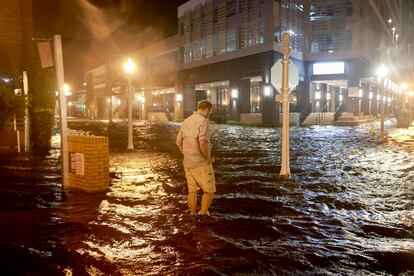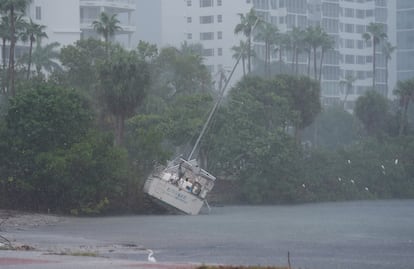Hurricane Milton, a view from ground zero: ‘In the eye of the storm, there is suddenly absolute calm, until it starts up again’
EL PAÍS visited Sarasota to see how residents are recovering from the double impact of Milton and Helene, which slammed into the area two weeks ago


In the residential neighborhoods of Sarasota, the reigning calm is deceptive. There is very little activity on the streets of the low-rise suburbs, as many roads are still completely cut off by branches, trees and power lines that were toppled by the hurricane. But among the tropical front lawns, with their palm trees and colorful plants, Flo Pondet stood in the sun, rake in hand, adding to the six-foot pile of debris that adorns the sidewalk in front of her house. “This isn’t all Milton’s doing — at least a quarter of it has been there since Helene,” she notes. The trauma and devastation on Florida’s Gulf Coast has doubled since Milton hit just a few miles away on Wednesday night in Siesta Key.
That’s precisely what Republican Governor Ron DeSantis, who is becoming an expert in disaster management, stressed. “You’re dealing with two hurricanes in a couple of weeks — which is not easy to deal with — but I’ve seen a lot of resilience across the state,” he said from Sarasota on Thursday afternoon. He added that he was “confident that this area will recover very, very quickly.”
Milton made landfall in Sarasota County as a Category 3 hurricane. While the damage was less than the worst-case forecast, it brought with it powerful winds that have left widespread devastation across the area, and authorities have warned that flooding is still possible in the coming days. The death toll statewide is at least 16 as of the latest count on Thursday night, though the number is expected to rise further in the coming days. Nearly 2.7 million people remained without power. Virtually all of the counties that suffered the most direct impact will be in the dark for another night, and there is no clear indication of when power will be restored.
After the hurricane moved out into the Atlantic off Cocoa Beach in the morning, emergency and rescue services went to work. According to the latest report by the governor late Thursday night, nearly 1,000 people and 105 animals have been rescued. There are still 23 urban search and rescue teams with more than 1,600 personnel deployed throughout the state, along with 10 swiftwater teams, plus 6,500 members of the Florida National Guard and another 2,500 expected from other states.

Hillsborough County deputies found a 14-year-old boy floating on a piece of fence, and a Coast Guard helicopter rescued a man who had been clinging to a cooler in the Gulf of Mexico after his fishing boat capsized in the storm. The agency estimated he had survived winds of 75 to 90 mph (121 to 145 kph) and waves of up to 25 feet (7.5 meters) during his night in the water. “This man survived a nightmare scenario for even the most experienced mariner,” said Coast Guard Lt. Cmdr. Dana Grady.
With emergency and rescue services concentrated on other, more affected areas such as the “islands,” which form a natural barrier to the mainland of the Florida peninsula and border the coast for miles, cleanup work on private properties is the responsibility of residents. Pondet arrived at her home to assess the damage — luckily minimal, because she had just replaced the roof and because the cyclone did not meet the worst forecasts of storm surges of up to four meters — early in the morning and has been working ever since.
The energy that she has displayed throughout the day is the product of anguish and the desire to return to a semblance of normality after spending a terrifying and dark night in a hotel near the airport. In this entire area, the power went out a few hours before the direct impact of the hurricane. “I have been here for 30 years and I had never felt the eye of the storm. Suddenly there is absolute calm, you don’t know what is happening, and as soon as you understand that it is because you are in the center of the storm, it starts again. I could barely sleep,” she says. Of the seven million people who were under evacuation orders, like Pondet, some 80,000 people spent the night in shelters.
In a neighborhood a little further north, Dale Williams barely made it home before the sun set. He had evacuated to an area in the north of the state to spend the night with friends, but because of the distance, and especially because of the road traffic from families returning home and the thousands of rescue teams with their trucks, it had taken him more than twice as long as usual to get back to his belongings. “I’m exhausted,” he said. He was planning to spend the night at home, and would have electricity thanks to a noisy generator that was already running.

Just a few blocks away, Pedro Lanz, a Venezuelan who has been in the United States for three years, but in Sarasota only since February, was also preparing for the night. He has no electricity, because he doesn’t have a generator, and no mosquito net because the wind blew it down. “I haven’t slept a wink because of the fright I had last night. I’m super tired. And when we arrived in the morning we started cleaning up so we could get in. Now I’m going to try to sleep, to see if the mosquitoes and the heat let me,” he says.
His house, because of the elevation on which it is located despite being just a few feet from the sea, did not suffer too much. Other houses in his neighborhood, however, were hit by a tree and are much more damaged. In the darkness of the streets without lighted lampposts, they seemed abandoned; perhaps their owners had not yet returned, perhaps they had and preferred to deal with it the next day. Even so, in this area the damage has been relatively minor. In areas where the houses are less robust and where the swells, although smaller than feared, came in from the coast, several buildings have been damaged beyond repair and people have been left with nothing.
Displaying the kind of Florida resilience that DeSantis highlighted, and of which citizens are also very proud, Lanz assured that surviving the cyclones that define this territory is a matter of preparation.
— Doesn’t this make you think twice about living here?
— No, I’m not leaving Florida.
Sign up for our weekly newsletter to get more English-language news coverage from EL PAÍS USA Edition
Tu suscripción se está usando en otro dispositivo
¿Quieres añadir otro usuario a tu suscripción?
Si continúas leyendo en este dispositivo, no se podrá leer en el otro.
FlechaTu suscripción se está usando en otro dispositivo y solo puedes acceder a EL PAÍS desde un dispositivo a la vez.
Si quieres compartir tu cuenta, cambia tu suscripción a la modalidad Premium, así podrás añadir otro usuario. Cada uno accederá con su propia cuenta de email, lo que os permitirá personalizar vuestra experiencia en EL PAÍS.
¿Tienes una suscripción de empresa? Accede aquí para contratar más cuentas.
En el caso de no saber quién está usando tu cuenta, te recomendamos cambiar tu contraseña aquí.
Si decides continuar compartiendo tu cuenta, este mensaje se mostrará en tu dispositivo y en el de la otra persona que está usando tu cuenta de forma indefinida, afectando a tu experiencia de lectura. Puedes consultar aquí los términos y condiciones de la suscripción digital.
More information
Archived In
Últimas noticias
NASA discovers Titan doesn’t have an ocean, but a ‘slushy ice layer’ that increases possibility of life
Innocence lost in the forest of the child soldiers: ‘Each leader of the armed group had his girls’
‘Fallout’ or how the world’s largest company turned an anti-capitalist apocalyptic Western into a phenomenon
From inflation to defending migrants: Eileen Higgins and Zohran Mamdani inaugurate the new Democratic resistance against Trump
Most viewed
- ‘El Limones’ and the growing union disguise of Mexican organized crime
- Christian Louboutin: ‘Young people don’t want to be like their parents. And if their parents wear sneakers, they’re going to look for something else’
- The low-cost creative revolution: How technology is making art accessible to everyone
- ‘We are dying’: Cuba sinks into a health crisis amid medicine shortages and misdiagnosis
- Liset Menéndez de la Prida, neuroscientist: ‘It’s not normal to constantly seek pleasure; it’s important to be bored, to be calm’










































